浙江大学有机化学课件讲义2
- 格式:pdf
- 大小:546.81 KB
- 文档页数:36
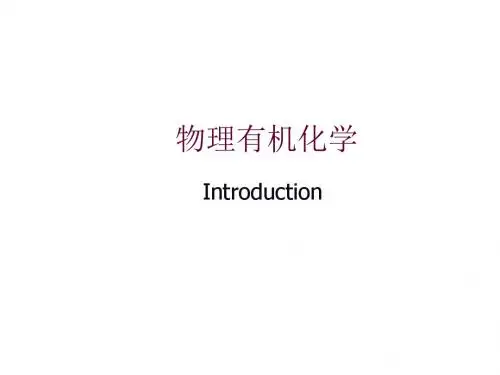
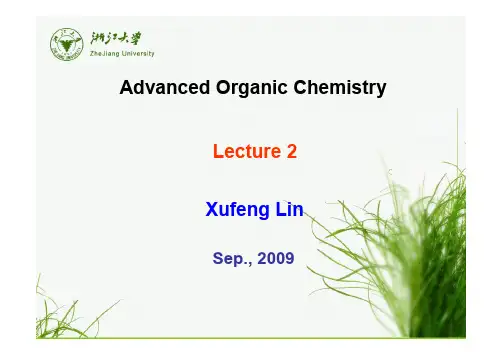
Advanced Organic ChemistryLecture 2Xufeng LinSep., 20092. StereochemistryChirality in ToolsHelixChirality in ArtØDopamine ØL-DOPA ØProdrug ØDecarboxylationL-DOPAIf we consider the biological activities of chiral compounds in general, there are four different behaviors:1)only one enantiomer has the desired biologicalactivity, and the other one does not show signifcantbioactivity;2)both enantiomers have identical or nearly identicalbioactivity;3)the enantiomers have quantitatively different activity;4)the two enantiomers have different kinds of biologicalactivity.天冬酰胺薄荷OH OH OO OHOHOHOO OHS-(+)-Alkannin (R)-(-)-Shikoninv The toxicity of naturally occurring (-)-nicotine is much greater than that of unnatural (+)-nicotine.v Chiral herbicides, pesticides, and plant growth regulators widely used in agriculture also show strong biodiscriminations.Conditions for Asymmetryq Amines with three different substituents are potentially chiral because of the pseudotetrahedral arrangement of the three groups and the lone-pair electrons. Under normal conditions, however, these enantiomers are not separable because of the rapid inversion at the nitrogen center.q In contrast to the amines, inversion of configuration for phosphines is generally negligibly slow at ambient temperature. This property has made it possible for chiral phosphines to be highly useful as ligands in transitionmetalcatalyzed asymmetric syntheses.q As a result of the presence of lone-pair electrons, the configuration of organosulfur species is pyramidal, and the pyramidal reversion is normally slow at ambient temperature. Thus two enantiomers of chiral sulfoxides are possible and separable.In the case of nitrogen compounds, if the inversion at the nitrogen center is prevented by a rigid structural arrangement, chirality also arises.The bridgehead structure completely prevents inversion.In a three-membered heterocyclic ring, the energy barrier for inversion at the nitrogen center is substantially raised.NomenclatureCl多少对enantiomersdiastereomersNO 2COOH NO 2COOH COOHNO NO 2COOH Br I Br XI Br I BrC C C abaCCCHH3C3C C CHCH3H3C EnantiomersCF2 F2C2 F2CF3F2C CF2 F2CF2 F3C(S)(R)Planar chiralityp S p SChiral centerp S构象分析分子将采取能量最低的几何形状,这种几何形状是通过围绕单键的旋转而达到的。

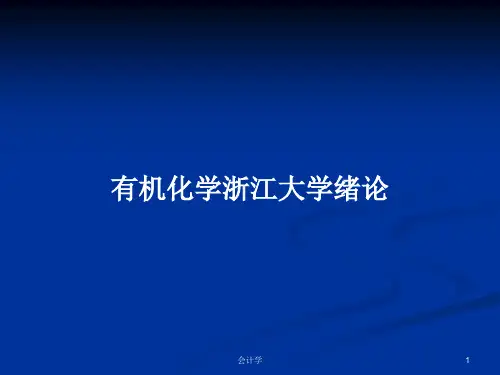
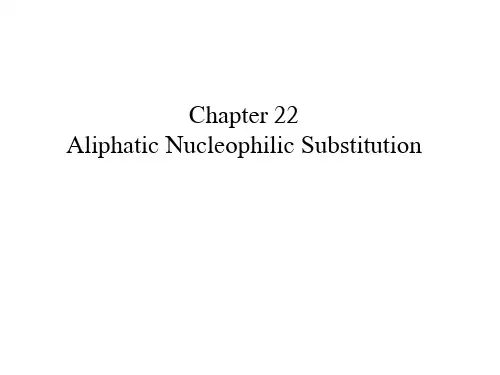
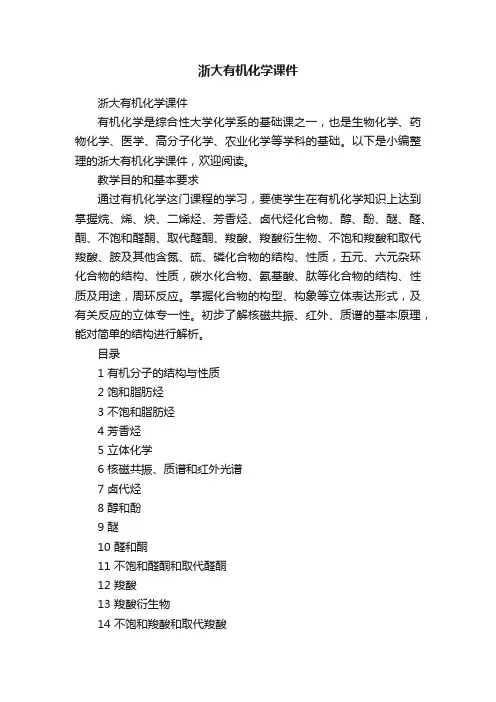
浙大有机化学课件浙大有机化学课件有机化学是综合性大学化学系的基础课之一,也是生物化学、药物化学、医学、高分子化学、农业化学等学科的基础。
以下是小编整理的浙大有机化学课件,欢迎阅读。
教学目的和基本要求通过有机化学这门课程的学习,要使学生在有机化学知识上达到掌握烷、烯、炔、二烯烃、芳香烃、卤代烃化合物、醇、酚、醚、醛、酮、不饱和醛酮、取代醛酮、羧酸、羧酸衍生物、不饱和羧酸和取代羧酸、胺及其他含氮、硫、磷化合物的结构、性质,五元、六元杂环化合物的结构、性质,碳水化合物、氨基酸、肽等化合物的结构、性质及用途,周环反应。
掌握化合物的构型、构象等立体表达形式,及有关反应的立体专一性。
初步了解核磁共振、红外、质谱的基本原理,能对简单的结构进行解析。
目录1 有机分子的结构与性质2 饱和脂肪烃3 不饱和脂肪烃4 芳香烃5 立体化学6 核磁共振、质谱和红外光谱7 卤代烃8 醇和酚9 醚10 醛和酮11 不饱和醛酮和取代醛酮12 羧酸13 羧酸衍生物14 不饱和羧酸和取代羧酸16 其他含氮化合物18 杂环化合物19 碳水化合物20 氨基酸、蛋白质和核酸21 类脂、萜类化合物、甾族化合物和生物碱22 周环反应23 有机合成1 有机化合物的结构和性质1.1了解有机化学的发展史以及有机化学与生命科学的关系;1.2 有机分子的结构:共价键、碳原子的特性及有机化合物分子的立体形象;1.3 有机化合物分子的表示法:实验式、结构式、投影式;1.4 有机化合物中的共价键:碳原子的杂化轨道;?键和?键;1.5 价键理论;分子轨道理论;共振论;1.6 共价键的属性;键长、键角、键能、极性和极化度;1.7 酸碱理论:布朗斯特酸碱和路易斯酸碱理论;1.8 有机化合物结构和物理性质的关系,分子间力(范德华力和氢键)对溶解度、沸点、熔点、比重的影响。
2 饱和脂肪烃2.1 烷烃的结构:sp杂化;同系列;烷基的概念;同分异构现象;伯、仲、叔、季碳原子的概念;烷烃分子的构象:Newman投影式,重叠式与交叉式构象及能垒。


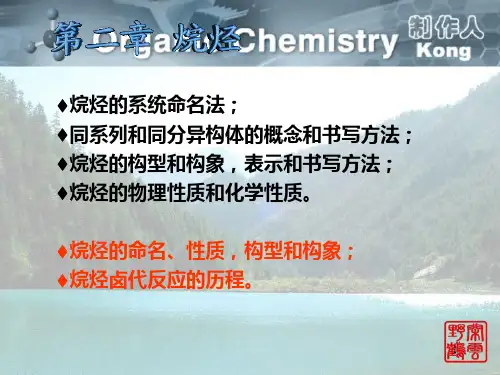
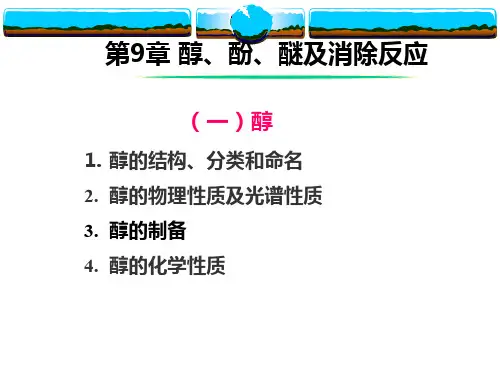
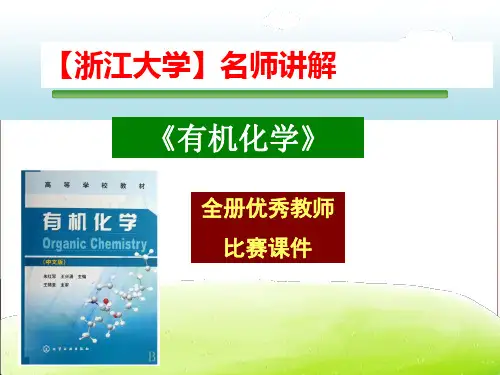
生物有机化学Bioorganic Chemistry参考资料:1、古练权,马林,生物有机化学,高等教育出版社,19982、H. Dugas, Bioorganic Chemistry, 3rd Ed., Springer, 19953、刘育,尤长城,张衡益编著,超分子化学-合成受体的分子识别与组装,p385-400,南开大学出版社,20014、原始文献第一章绪论§1.1 生物分子与生物有机化学自然界中所有生物体的物质组成水生物分子金属离子(生物无机化学)蛋白质、核酸、糖、脂、维生素、激素等生物有机化学的研究对象、方法和结果生物分子和生物活性物质有机化学研究生物化学研究(结构测定,反应机制,(分离,提纯,生物功能化学合成,化学修饰)生物合成,基因研究)分子模型和实验室模拟研究设计合成新的生物分子与生物活性物质应用§1.2 生物大分子1、常见官能团2、基本结构单元3、立体结构的维系生物大分子中的重要官能团生物大分子中常见的其他基团2、基本结构单元一氨基一羧基酸一氨基二羧基酸、二氨基一羧基酸芳香及杂环氨基酸构成核酸的结构单元分子构成脂和糖的结构单元分子3、立体结构的维系共价键氢键配价键离子键疏水作用范德华作用力氢键及其典型的键长DNA碱基对中的氢键键酶的选择性结合(氢键)血红蛋白中的配价键酶中的离子键范德华力与距离的关系使蛋白质相互连接的作用(力)§1.3 生物体内发生的基本化学反应水解及缩合酯键,酰胺键,糖苷键的水解。
缩合是水解的逆反应如氧化和还原碳链增长反应DNA的烷基化及去烷基化磷酰化反应ATP(adenosine triphosphate),三磷酸腺苷分子重排反应异构化反应§1.4 生物有机化学的立体效应K 1/K 2=104一、邻基效应(proximity effect )二、潜手性中心与潜手性面的选择乙醛分子的潜手性面乙醛加氘生成手性醇的反应醇和辅酶NAD+作用NAD +(nicotinamideadenine dinucleotide ),即烟酰胺腺嘌呤二核苷酸N O氘代乙醇和辅酶NAD+的氧化还原反应YADH(yeast alcohol dehydrogenase)酵母乙醇脱氢酶还原三、生物分子的相互作用与超分子5‘●●●●●●●●●●●3’A T G C G T A T GT A C G C A T A C3’●●●●●●●●●●●5’DNA碱基对的识别。